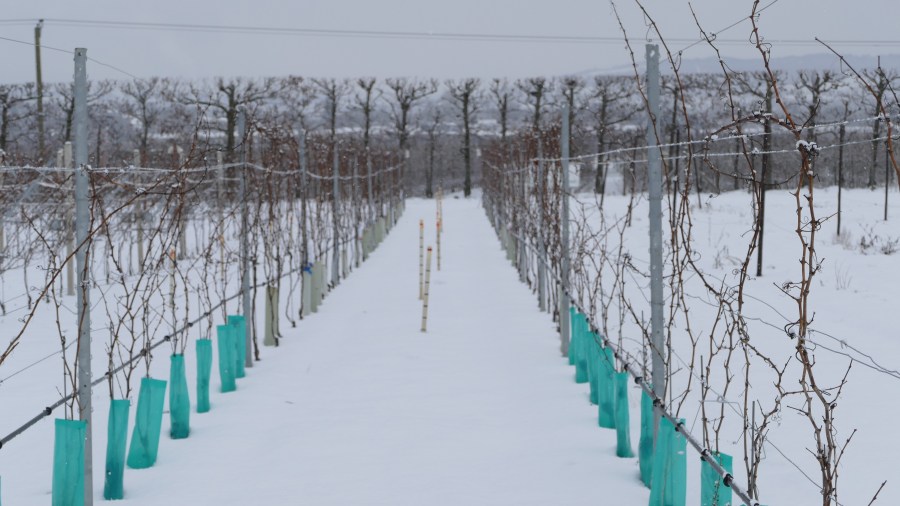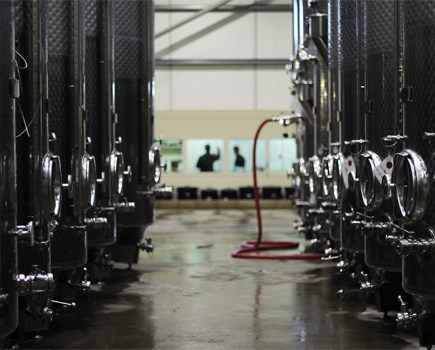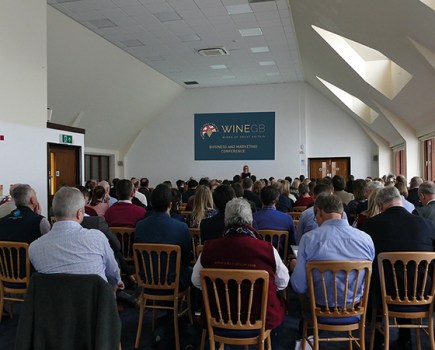Recognising that there was a requirement to develop and deliver a science-based viticulture service for growers in the UK, Dr Julien Lecourt approached his colleagues at research centre, NIAB EMR.
After completing his PhD in the study of rootstock effect on nitrogen use efficiency in grafted grapevines at the University of Bordeaux, France, Julien joined NIAB EMR four years ago to focus on research into orchard pruning systems and how manipulation of the plant’s microclimate could increase productivity, yield and profitability.
New to the area and a lover of wine, Julien started to discover and visit many of the wineries in Kent and realised very quickly that they were not supported by scientific research.
“We have very well-educated growers in this country, but it is still very difficult to grow vines in our marginal climate,” said Dr Julien Lecourt. “One of the biggest challenges was there were no guidelines on how to grow vines specifically in the UK. There was no solid scientific data being acquired and coming from France where this infrastructure is already in place it was clear there was a real need to develop a science based viticulture offering for the UK.”
With NIAB EMR divided into three teams covering genetics, genomics and breeding; pest and pathogen ecology; and crop science and production systems there was an opportunity to work collectively to research viticulture and offer a lot to the industry.
“The first thing we did was to enter discussions with the local vineyards,” said Julien. “We tested our ideas with them, explaining what we wanted to achieve and how we could see it working in practice, and in 2015 we planted the research vineyard at our site in East Malling.”
Designed for research
The concept vineyard, which now spans just over one hectare, was specifically designed and planted for science and is the only vineyard in the UK dedicated to research, not production. Bacchus, Chardonnay, Pinot blanc, Pinot meunier and Pinot noir vines are randomly spread across the site in blocks with a repetition of five plants and there are multiple sensors placed in the soil and air for monitoring, creating an ideal research environment.
“We planted the research vineyard to be able to test ideas,” said Julien. “If trials have an impact, we can then go on to test them at a larger scale in commercial vineyards. There is a complete pipeline of research in place. We can work on cell cultures in the laboratories, cuttings in the glass houses, potted plants in the polytunnels, the vines in the research vineyard and then we would move on to a commercial scale. We cover the whole spectrum of scale when it comes to research and development.”
With its extensive laboratory infrastructure and broad skill-set of experts under one roof, NIAB EMR works on a range of varieties, from apples and pears, to strawberries and plums, which all share similar issues to those faced in the UK’s grape growing sector.
“We are looking at the tools and the skill sets we have at NIAB EMR and we are transferring that to the UK viticulture sector,” said Julien. “Over the next year we are hoping to accelerate the transfer of knowledge from our core research and expertise to the viticulture sector. For instance, Michelle Fountain is a world expert in Spotted Wing Drosophila (SWD) and we will be working in collaboration with Plumpton College to show growers how to manage this pest according to the findings we have at NIAB EMR.”
Following NIAB EMR’s moto of ‘science into practise’, the work Julien and the team conduct on the research vineyard is focused on helping vineyards to overcome the key issues with growing, yield and profitability.
“We are ultimately trying to help growers implement better practices,” said Julien. “From training and pruning, to canopy management, spray efficiency, pest and disease management, weed management, varieties and clones, to soil quality, we are really doing everything we can.”
Competitive advantage
As well as conducting independent assessments with industry partners, such as Agrii, to ensure that the products are best suited for UK customers, a vineyard consortium was also established with some of the UK’s top players including, Bolney Wine Estate, Chapel Down, Nyetimber, Gusbourne Estate and Halfpenny Green.
“The consortium is democratically driven,” said Julien. “We meet to discuss the concerns they are facing, such as limits to their profitability, and then we propose a solution. They vote on the priorities and according to this we perform the research; it is their consortium. Sharing the information across members works very well because you have more variables, such as soil and geography, and more results to work from.”
To provide members with a competitive advantage, all the findings produced from consortium research are strictly confidential. Vineyards interested in joining the consortium should contact Julien, or the group’s chairman Geoff Taylor at Camden BRI.
To date, viticulturists in the UK have largely copied best practice implemented in other regions but Julien is keen to establish growing methods tailored specifically to the UK climate.
Focused on helping growers to do the right things at the right time in the vineyard, Julien and NIAB EMR’s new intern Paul Tuteirihia from the University of Champagne, are currently working on a project to examine the effects of canopy management on Pinot noir quality and yield.
“So far, we have seen that through simple canopy manipulations, such as the timing and intensity of leaf removal, the aromatic profile of Pinot noir can be altered significantly,” said Julien. “We will be publishing the full data soon.”
A holistic approach
To benefit the whole industry, NIAB EMR is also performing a lot of non-competitive research. After winning a competitive bid, one of the latest projects the centre has taken on is funded by Horizon 2020, the EU’s largest research and innovation funding programme, and will investigate effective integrated weed management (IWM) in the vineyard.
“We see less and less herbicides on the shelf but what are the alternatives to weed control and how do they impact on the quality, yield or profitability?” said Julien. “Within the IWM Praise project we will be doing research on behalf of all the vineyards in the EU, which has really put NIAB EMR on the map for viticultural research and development.”
Having commenced in June 2017, the IWM Praise project will run until May 2022 and will see NIAB EMR plant a new research vineyard specifically designed to test different strategies of weed management, from herbicides, to mechanical weeders as well as cover crops.
“We will be monitoring the effect of the different strategies in terms of timing of implementation, soil quality and impact on fruit quality, yield and the growth of the plant,” said Julien. “We are taking a really holistic approach and will be developing mathematical models of the weeds’ growth as well as building imaging tools to assess weeds’ rate of growth. The NIAB EMR viticulture laboratory will then analyse berry and bunch quality.”
Benefiting from the merger of East Malling Research with the NIAB Group in 2016, Julien will be working closely with some of the best weeds experts in the UK. While their research has historically focused on arable crops there will still be a huge advantage to the viticulture sector from drawing from these skill sets and experiences.
Careful collaboration
As well as internal collaboration, NIAB EMR is also working with other research facilities and higher education providers to better understand the issues growers face today and also in the long term.
Working with the University of Greenwich, a survey was issued to UK growers to look at which viruses were present in vineyards, with the next stage of the research focusing on the effect these have on productivity, quality and yield.
“To have an effect on the industry we first needed to identify the problems,” said Julien. “A lot of growers know they have some viruses but we are carrying out a complete screening to identify the type and strains of viruses in the UK. We will prioritise which ones are the biggest threat and work from there.”
To studying the effects of climate change and global warming, Julien is working with the University of Bordeaux on a project to identify which varieties will be able to grow successfully in the UK in 15, 20 and 30 years’ time.
“Looking at varieties which are no longer suitable for growers in Bordeaux but not yet suitable for the UK, we have planted an identical plot at our East Malling research vineyard to the University of Bordeaux,” said Julien. “It is the same varieties on the same rootstock. We are following the same protocol, using the same equipment and we are measuring quality in both locations.”
With plantings of Sauvignon blanc, Reisling, Merlot and Chenin, Julien is hoping the research will improve the accuracy in predicting which varieties UK growers will be able to plant in the next 25 years.
Clonal viability
Continuing to look at bespoke vines for the UK market, alongside testing unreleased varieties from Germany and Switzerland to see how they perform in the UK, NIAB EMR is working with French nursery Pépinières Guillaume on clonal viability.
The research vineyard is now home to a collection of different Pinot noir and Chardonnay clones including the ones mostly used in the UK and some which are not used at all but have potential, which will be tested for bunch quality and yield potential.
“We need to look at whether the planting material is really suited to the UK climate,” said Julien. “Just because it is good for Champagne, doesn’t mean it is good for our climate. We have our own terroir and may not be using the best clones.”
Thermal imaging technology
As climate change continues and earlier bud burst opens up the window for frost, NAIB EMR is keen to monitor the risks. During the late frost events in April 2017, Julien and the team measured the temperature of various organs of the plant, including the canes and buds, to try and link the growth stage of the plant, the clone and soil management, with frost damage.
“As well as using the thermal imaging cameras we have on site, we took date from the sensors in the soil and in the air,” said Julien. “Continuous measurements were recorded from one o’clock in the night to ten o’clock in the morning during the different late frost events and frost damage was later recorded.”
After one year it is still too early to confirm the findings and Julien will be continuing the research this year while also testing frost management methods, such as sprays and candles as well as installing sprinklers in the vineyard in early 2018.
Demonstrating the results
The research vineyard is also used to take ideas to a semi-commercial scale to demonstrate that the science works in practice and could be adapted by growers. This year’s leaf removal work undertaken by intern Paul will be informed by the research which has been obtained on canopy management and eventually weeds will be managed across the vineyard according to the finding from the IWM Praise project.
“We are putting the pieces in place one by one to create this perfect demonstration vineyard,” said Julien. “The idea is to bring everything together at a semi commercial scale and we welcome growers to come and visit the site to see the results of the experiments. We want to create a hub to bring people together and share knowledge.”
Being a perennial crop, viticulture research programmes last for a minimum of three years and having only planted the vineyard in 2015 there is a long journey ahead before NIAB EMR will start to release a lot of its findings.
“We will start communicating our findings when we know they are true and will work for growers,” said Julien. “Research takes time and we are still building the foundations. Three years ago, there was no research vineyard, no one was looking at alternatives, and no one was drawing a scientific base line for the limiting factors of growing vines in the UK.”
Once it is ready to share with the industry, NIAB EMR will act as an interface between the basic research and the growers and will facilitate the transfer of science-based knowledge and convey the findings for growers to use to make the best decisions.
“It is this science-based decision making which we are trying to give to growers,” said Julien. “As well as looking at the bunch quality, yield and plant performance across our research we also look at the economic impact as our findings do need to make sense to growers.”
Looking to the future, as well as applying for to more funding programmes to increase the research opportunities, the viticulture team at NIAB EMR have just signed a partnership with a vineyard equipment manufacturer to test the effects of machinery on plant performance. The team is also looking into developing precision agriculture tools for vineyards as well as robotics which can help to reduce reliance on labour and associated costs.




